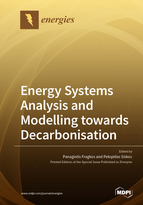Energy Systems Analysis and Modelling towards Decarbonisation
A special issue of Energies (ISSN 1996-1073). This special issue belongs to the section "A: Sustainable Energy".
Deadline for manuscript submissions: closed (31 October 2021) | Viewed by 33712
Special Issue Editors
Interests: energy modelling; energy economics; energy systems analysis; climate change mitigation pathways
Special Issues, Collections and Topics in MDPI journals
Special Issue Information
Dear Colleagues,
The Paris Agreement establishes a process to combine Nationally Determined Contributions with the long-term goal of limiting global warming to well below 2 °C and even to 1.5 °C. Responding to this challenge, national and regional low-emission strategies are prepared by EU and non-EU countries outlining clean energy transition pathways. The aim of this Special Issue is to provide rigorous quantitative assessment of the challenges, impacts and opportunities induced by ambitious low-emission pathways. It aims to explore how deep emission reductions can be achieved in all energy demand and supply sectors, exploring the interplay between mitigation options, including energy efficiency, renewable energy uptake and electrification to decarbonise inflexible end-uses such as mobility and heating. The high expansion of renewable energy poses high technical and economic challenges with regard to system configuration and market organisation, requiring the development of new options, such as batteries, prosumers, grid expansion, chemical storage through power-to-X and new tariff setting methods. The uptake of disruptive mitigation options (hydrogen, CCUS, clean e-fuels) as well as carbon dioxide removal (BECCS, direct air capture, others) may also be required in the case of net zero emission targets but raises market, regulatory and financial challenges. This Special Issue will assess low-emission strategies at the national and global level and their implications for energy system development, technology uptake, energy system costs as well as the socioeconomic and industrial impacts of low-emission transitions.
Dr. Panagiotis Fragkos
Dr. Pelopidas Siskos
Guest Editors
Manuscript Submission Information
Manuscripts should be submitted online at www.mdpi.com by registering and logging in to this website. Once you are registered, click here to go to the submission form. Manuscripts can be submitted until the deadline. All submissions that pass pre-check are peer-reviewed. Accepted papers will be published continuously in the journal (as soon as accepted) and will be listed together on the special issue website. Research articles, review articles as well as short communications are invited. For planned papers, a title and short abstract (about 100 words) can be sent to the Editorial Office for announcement on this website.
Submitted manuscripts should not have been published previously, nor be under consideration for publication elsewhere (except conference proceedings papers). All manuscripts are thoroughly refereed through a single-blind peer-review process. A guide for authors and other relevant information for submission of manuscripts is available on the Instructions for Authors page. Energies is an international peer-reviewed open access semimonthly journal published by MDPI.
Please visit the Instructions for Authors page before submitting a manuscript. The Article Processing Charge (APC) for publication in this open access journal is 2600 CHF (Swiss Francs). Submitted papers should be well formatted and use good English. Authors may use MDPI's English editing service prior to publication or during author revisions.
Keywords
- Energy system modelling
- Deep decarbonisation pathways
- Energy and climate policy analysis
- Energy markets and climate change






